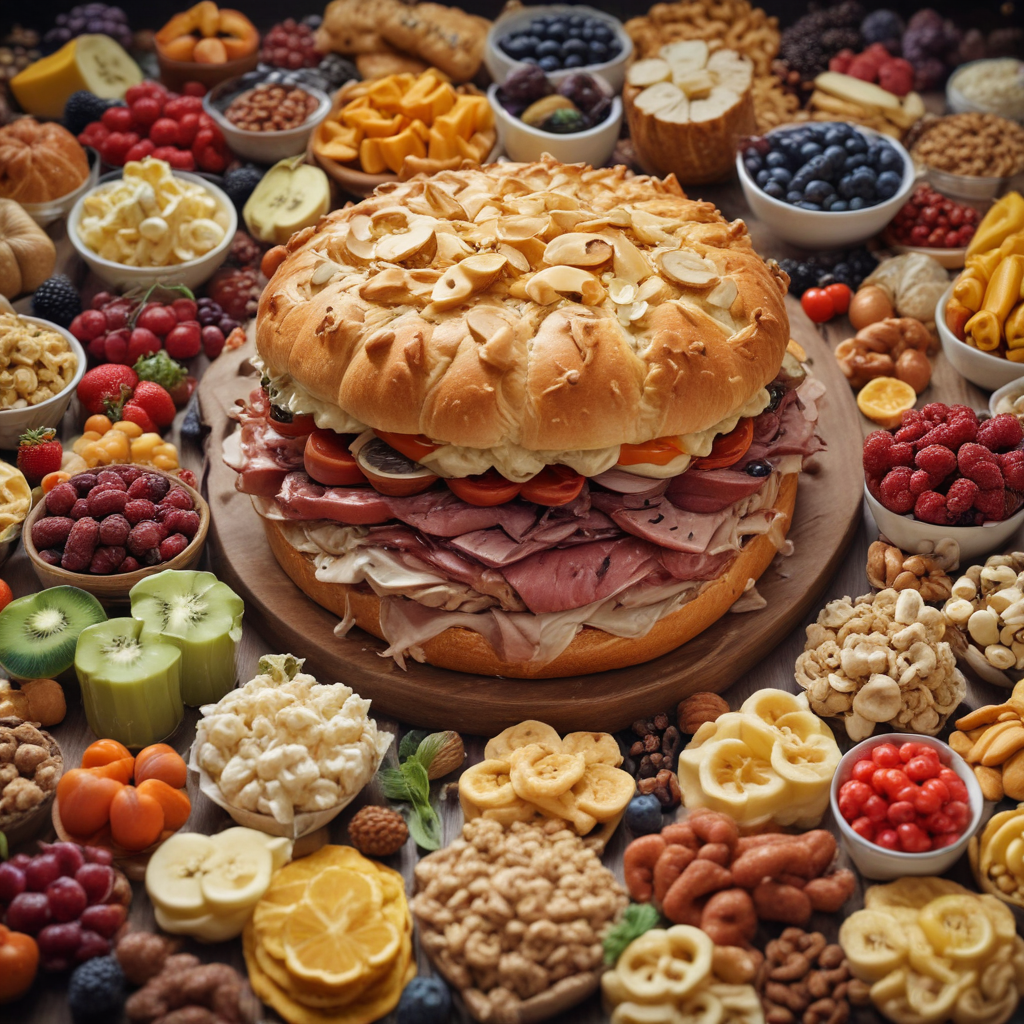
Snack Diversity: Embracing a Range of Flavors and Ingredients
1. Introduction
Snacking plays a crucial role in a healthy diet, providing essential nutrients and energy throughout the day. With the rise of snack culture, food trends are shifting towards a more diverse and flavorful snacking experience. Embracing snack diversity offers numerous benefits, including:
- Enhanced Nutrition: By incorporating a wider range of ingredients, you can ensure your body receives a variety of vitamins, minerals, and antioxidants.
- Culinary Exploration: Snacking becomes an exciting adventure, allowing you to discover new flavors and textures from different cultures.
- Promotes Mindful Eating: A diverse snack selection encourages mindful eating, helping you appreciate the unique characteristics of each snack.
- Reduces Boredom: Say goodbye to repetitive snacking and embrace the excitement of trying new combinations and flavors.
- Supports Local Businesses: Choosing diverse snacks often means supporting local farmers and small businesses, contributing to a more sustainable food system.
2. Embracing Global Flavors
The world is your oyster when it comes to snacking. Explore the diverse world of snacks from different cultures, each offering unique ingredients and flavor profiles.
- Asian Snacks: Dive into the vibrant world of Asian snacks, from the savory dumplings and spring rolls of China to the spicy kimchi and seaweed snacks of Korea.
- Mediterranean Delights: Experience the freshness and health benefits of Mediterranean snacks, such as hummus with pita bread, olives, and dolmas.
- Latin American Flavors: Explore the bold and flavorful snacks of Latin America, including plantain chips, empanadas, and spicy salsas.
- African Snacks: Discover the unique and diverse snacks of Africa, from the savory samosas and mandazi of East Africa to the spicy suya and puff puff of West Africa.
By embracing global flavors, you can expand your culinary horizons and discover new favorites while appreciating the cultural significance behind each snack.
3. Expanding Your Vegetable Horizons
Vegetables are essential for a healthy diet, and snacking provides a perfect opportunity to incorporate more of them into your daily routine. Get creative with your vegetable preparation to make them more appealing and enjoyable.
- Raw Vegetable Platters: Choose a variety of colorful vegetables like carrots, celery, peppers, and cucumbers, and pair them with delicious dips like hummus or guacamole.
- Roasted Vegetables: Roasting vegetables like broccoli, cauliflower, and Brussels sprouts enhances their flavor and creates a crispy texture.
- Vegetable Smoothies: Blend your favorite vegetables with fruits and yogurt for a refreshing and nutritious smoothie.
- Vegetable Fritters: Combine grated vegetables with eggs and flour to create savory and satisfying fritters.
Remember, even small changes can make a big difference. By incorporating more vegetables into your snacks, you'll be well on your way to a healthier and more diverse diet.
4. Sweet Treats with a Healthy Twist
Indulge your sweet tooth while still maintaining a healthy diet. By using natural sweeteners and whole food ingredients, you can create delicious and nutritious sweet snacks.
- Fruit Salads: Combine a variety of fresh fruits for a refreshing and naturally sweet treat.
- Baked Apples: Fill baked apples with nuts, seeds, and cinnamon for a warm and comforting dessert.
- Homemade Trail Mix: Create your own trail mix with nuts, seeds, dried fruits, and dark chocolate chips.
- Energy Balls: Combine dates, nuts, seeds, and rolled oats for bite-sized energy balls that are perfect for on-the-go snacking.
With a little creativity, you can enjoy sweet treats without compromising your health goals.
5. Savory Delights for the Adventurous Palate
Treat your taste buds to a savory adventure with unique and flavorful snacks. Explore different ingredients and combinations to create satisfying and delicious options.
- Spiced Chickpeas: Roast chickpeas with spices like curry powder, paprika, or cumin for a crunchy and flavorful snack.
- Edamame: Enjoy steamed or roasted edamame for a healthy and protein-rich snack.
- Avocado Toast: Top whole-grain toast with mashed avocado, cherry tomatoes, and a sprinkle of chili flakes for a quick and satisfying snack.
- Pickled Vegetables: Experiment with pickling different vegetables like cucumbers, carrots, and onions for a tangy and crunchy snack.
By venturing beyond the ordinary, you'll discover a world of savory delights that will tantalize your taste buds.
6. The Power of Whole Grains
Whole grains are nutritional powerhouses, providing an abundance of fiber, vitamins, minerals, and antioxidants. Incorporating whole grains into your snacks can significantly boost your overall health and well-being.
Benefits of Whole Grains:
- Improved Digestion: The fiber in whole grains aids in digestion and promotes regularity.
- Reduced Risk of Chronic Diseases: Whole grains have been linked to a lower risk of heart disease, type 2 diabetes, and certain types of cancer.
- Stable Energy Levels: The complex carbohydrates in whole grains provide sustained energy release, preventing energy crashes.
- Weight Management: Whole grains are filling and satisfying, helping you manage your weight effectively.
Whole-Grain Snack Options:
- Whole-Wheat Crackers: Choose whole-wheat crackers over refined crackers for a fiber-rich snack.
- Oatmeal: Oatmeal is a versatile and nutritious snack that can be enjoyed with fruits, nuts, or seeds.
- Popcorn: Air-popped popcorn is a low-calorie and whole-grain snack that is high in fiber.
- Whole-Grain Tortillas: Use whole-grain tortillas to make wraps or quesadillas with lean protein and vegetables.
- Homemade Granola Bars: Create your own granola bars with rolled oats, nuts, seeds, and dried fruits for a healthy and satisfying snack.
By making conscious choices and incorporating whole grains into your snacks, you can reap their numerous health benefits and improve your overall well-being.
7. Experimenting with Seeds and Nuts
Seeds and nuts are nutritional treasures, packed with protein, healthy fats, fiber, vitamins, and minerals. These tiny powerhouses can transform your snacks into nutrient-dense and flavorful delights.
Benefits of Seeds and Nuts:
- Heart-Healthy Fats: Seeds and nuts are rich in unsaturated fats, which promote heart health and lower cholesterol levels.
- Plant-Based Protein: They provide a valuable source of plant-based protein, essential for building and repairing tissues.
- Fiber and Minerals: Seeds and nuts are high in fiber, promoting digestive health and providing essential minerals like magnesium, zinc, and iron.
- Antioxidant Power: They are loaded with antioxidants, protecting your cells from damage and reducing the risk of chronic diseases.
Creative Ways to Incorporate Seeds and Nuts:
- Trail Mix: Combine your favorite seeds and nuts with dried fruits for a balanced and satisfying snack.
- Seed Butters: Spread almond butter, cashew butter, or sunflower seed butter on whole-wheat toast or crackers.
- Smoothie Boosters: Add a spoonful of chia seeds or flaxseeds to your smoothies for added fiber and nutrients.
- Salad Toppings: Sprinkle pumpkin seeds, sunflower seeds, or chopped nuts on your salads for extra crunch and flavor.
- Baked Goods: Incorporate ground flaxseeds or chia seeds into your baked goods for added moisture and nutritional value.
By getting creative with seeds and nuts, you can enhance the flavor and nutritional profile of your snacks while reaping their numerous health benefits.
8. Cultivating a Sustainable Snacking Habit
Making conscious choices about your snacks can positively impact the environment and support sustainable practices.
Eco-Friendly Snacking:
- Choose Local and Seasonal Produce: Opt for snacks made with locally grown and seasonal produce to reduce transportation emissions and support local farmers.
- Reduce Packaging Waste: Choose snacks with minimal packaging or opt for reusable containers.
- Compost Food Scraps: Compost fruit and vegetable scraps to reduce landfill waste and enrich your soil.
- Support Sustainable Brands: Choose snacks from companies committed to sustainable practices, such as using recycled materials or reducing their carbon footprint.
Sustainable Snack Options:
- Fresh Fruits and Vegetables: Choose fresh produce over processed snacks whenever possible.
- Homemade Snacks: Prepare your own snacks using whole, unprocessed ingredients to reduce packaging waste.
- Bulk Foods: Purchase nuts, seeds, and grains in bulk to reduce packaging and save money.
- Reusable Containers: Use reusable containers to store your snacks and reduce single-use plastics.
By making these simple changes, you can contribute to a more sustainable food system and minimize your environmental impact.
9. The Joy of Mindful Snacking
Snacking mindfully involves paying attention to the experience of eating, savoring the flavors, and appreciating the nutrients your body is receiving.
Benefits of Mindful Snacking:
- Improved Digestion: Slowing down and chewing thoroughly aids in proper digestion and nutrient absorption.
- Enhanced Flavor Appreciation: Mindful eating allows you to fully appreciate the taste, texture, and aroma of your snacks.
- Reduced Stress and Anxiety: Focusing on the present moment and the sensory experience of eating can reduce stress and promote relaxation.
- Weight Management: Mindful eating helps you make conscious choices about your food intake, preventing overeating.
Tips for Mindful Snacking:
- Create a Calm Environment: Find a quiet and comfortable place to enjoy your snack without distractions.
- Engage Your Senses: Pay attention to the colors, textures, aromas, and flavors of your snack.
- Chew Thoroughly: Take small bites and chew each bite slowly to savor the taste and aid digestion.
- Put Down Your Phone: Avoid distractions and focus on the present moment while enjoying your snack.
- Connect with Your Hunger Cues: Tune into your body's hunger signals and eat only when you are truly hungry.
By incorporating mindful eating practices into your snacking routine, you can transform it into an enjoyable and nourishing experience.
10. Conclusion
Snacking can be an integral part of a healthy and balanced diet. By embracing diversity, experimenting with ingredients, and making conscious choices, you can transform your snacking habits into a journey of culinary exploration, mindful eating, and sustainable practices. Remember, every snack choice is an opportunity to nourish your body, explore new flavors, and contribute to a more sustainable future.


